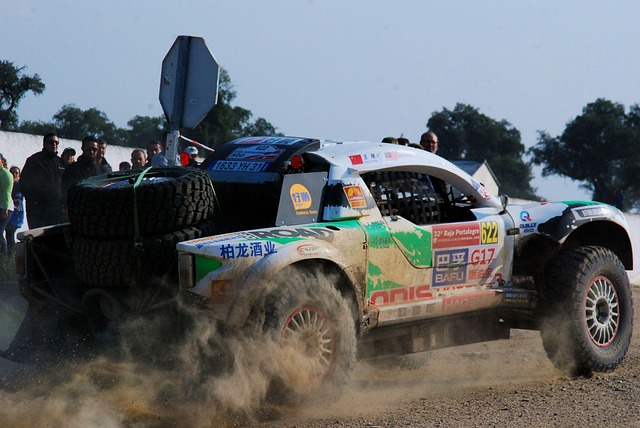Brownsville truck diagnosis tools revolutionize vehicle inspection, especially for recovery straps, key in efficient and secure heavy-duty vehicle towing and hauling. Versatile recovery strap types cater to diverse needs, with material strength and width matching specific tasks crucial. Proper training and regular maintenance ensure safe handling practices, preventing catastrophic failures. Early detection through modern diagnostic tools identifies issues like frayed cables, enhancing vehicle efficiency and safety during recoveries.
“Recovery straps are indispensable tools for truck mechanics, offering a reliable solution for vehicle recovery and towing. This comprehensive guide delves into the intricacies of these essential components, highlighting their role as advanced diagnosis tools in the hands of experts. We explore how Brownsville, a hub for trucking innovation, leverages sophisticated strap technology to navigate complex truck repairs. From understanding strap types to safe handling practices, this article equips professionals with the knowledge to tackle recovery challenges effectively.”
- Understanding Recovery Straps: Essential Tools for Truck Mechanics
- Brownsville's Role: Diagnosing Trucks with Advanced Strap Technology
- Types of Recovery Straps: A Comprehensive Guide for Professionals
- Choosing the Right Strap: Factors to Consider for Effective Recovery
- Safe Handling Practices: Ensuring Operator Safety with Recovery Straps
- Troubleshooting Common Issues: Resolving Strap Malfunctions in Trucks
Understanding Recovery Straps: Essential Tools for Truck Mechanics

Recovery straps are indispensable tools in the arsenal of any skilled truck mechanic. These robust and versatile tools serve as a lifeline for heavy-duty vehicles, offering a secure and reliable means to lift, tow, or support them during repair or recovery operations. In the bustling landscape of Brownsville’s trucking industry, where time is money and quick problem-solving is key, having the right diagnosis tools is paramount.
For truck mechanics in this vibrant community, recovery straps offer a practical solution for various challenges. Whether it’s extracting a vehicle from mud, securing a load during transport, or stabilizing a damaged truck for repairs, these straps provide the necessary grip and strength. With their superior durability and precision engineering, recovery straps ensure that mechanics can perform critical tasks efficiently, minimizing downtime and maximizing productivity on the job site.
Brownsville's Role: Diagnosing Trucks with Advanced Strap Technology

Brownsville, a leading innovator in truck maintenance and repair, has taken a significant step forward in diagnosing vehicle issues with their advanced strap technology. The company’s state-of-the-art tools are designed to identify and assess the condition of critical components within trucks, focusing on recovery straps—essential safety features. With precision and speed, these diagnostic tools enable mechanics to pinpoint weaknesses or damage, ensuring optimal performance and safety on the road.
Brownsville’s expertise in truck diagnosis goes beyond conventional methods. Their technology offers an in-depth analysis, allowing for early detection of potential problems. This proactive approach not only saves time but also plays a vital role in maintaining the overall health of recovery systems, ultimately contributing to the efficiency and reliability of fleet operations.
Types of Recovery Straps: A Comprehensive Guide for Professionals

Recovery straps come in various types, each designed for specific tasks and vehicle needs. For professionals, understanding these differences is crucial when selecting the right tool for Brownsville truck diagnosis. One common category is the chain recovery strap, ideal for heavy-duty towing and hauling due to its strength and durability. These chains are often used when dealing with large vehicles or in tough terrain.
Another type is the ratchet tie-down strap, versatile and secure for a range of applications. They feature an easy-to-use mechanism, making them popular among experts for fastening and securing loads. For specialized jobs, flat or webbing recovery straps offer a unique design, providing exceptional gripping power on uneven surfaces. Professionals appreciate their adaptability, especially in challenging diagnostic scenarios where precision and control are paramount, such as with Brownsville truck diagnosis tools.
Choosing the Right Strap: Factors to Consider for Effective Recovery

Choosing the right recovery strap is a crucial step in ensuring effective and safe vehicle recovery. When selecting a strap, consider factors like material strength, break strength, and width. Each vehicle and recovery scenario has unique demands, so choosing the appropriate strap for your needs is essential. For instance, if you’re dealing with heavy trucks in Brownsville, Texas, using high-strength steel straps rated for substantial weight capacity will be imperative.
Additionally, the length of the strap should match the distance between the towing vehicle and the stricken car to prevent excessive strain on either. Reputable manufacturers often provide detailed specifications, making it easier to find the perfect fit. Incorporating Brownsville truck diagnosis tools can also aid in identifying vehicle issues that may impact recovery efforts, further emphasizing the importance of compatible and robust recovery equipment.
Safe Handling Practices: Ensuring Operator Safety with Recovery Straps

Recovery straps are essential tools in the world of vehicle recovery and towing, especially for complex Brownsville truck diagnostics. To ensure operator safety during these operations, adhering to strict handling practices is paramount. Proper training is crucial; operators must understand the mechanics of the straps, their breaking strengths, and how to correctly apply them to different vehicle types and terrains.
When using recovery straps, it’s important to avoid overloading or misaligning them, which can lead to catastrophic failure. Regular inspection and maintenance are key; checking for any signs of wear, fraying, or damage before each use is vital. Incorporating these safe handling practices not only safeguards the operators but also prevents potential damage to both the recovery vehicle and the stricken truck, ensuring effective and efficient Brownsville truck diagnosis tools in every situation.
Troubleshooting Common Issues: Resolving Strap Malfunctions in Trucks

In the world of trucking, ensuring your vehicle’s reliability is paramount for safe and efficient operations. One common concern involves recovery straps, which can malfunction unexpectedly, causing significant delays. For truck owners in Brownsville, accessing the right tools for diagnosis is crucial. Modern diagnostic tools designed specifically for trucks offer advanced capabilities to pinpoint issues with accuracy. These tools allow mechanics or skilled drivers to test various components, including sensors, actuators, and mechanical connections within the strap system.
By utilizing these Brownsville truck diagnosis tools, professionals can swiftly identify problems such as frayed cables, loose connections, or faulty sensors—common causes of recovery strap malfunctions. Early detection enables prompt repairs or replacements, ensuring the straps function optimally when needed most. This proactive approach not only enhances vehicle performance but also boosts safety for both drivers and cargo during roadside recoveries.
Recovery straps are indispensable diagnostic and recovery tools for truck mechanics, especially when dealing with modern vehicle systems. As Brownsville has demonstrated, advanced strap technology plays a pivotal role in accurately diagnosing truck issues. By understanding different strap types, considering material strength, and adhering to safe handling practices, professionals can ensure effective recovery operations. With the right knowledge and equipment, these straps revolutionize truck maintenance, making them essential for any fleet or garage looking to enhance their service capabilities.
